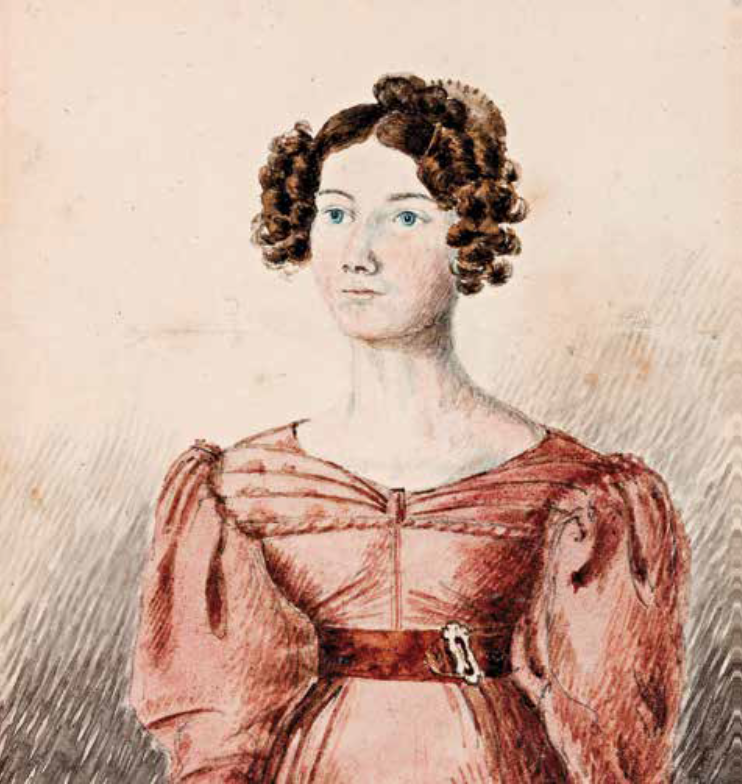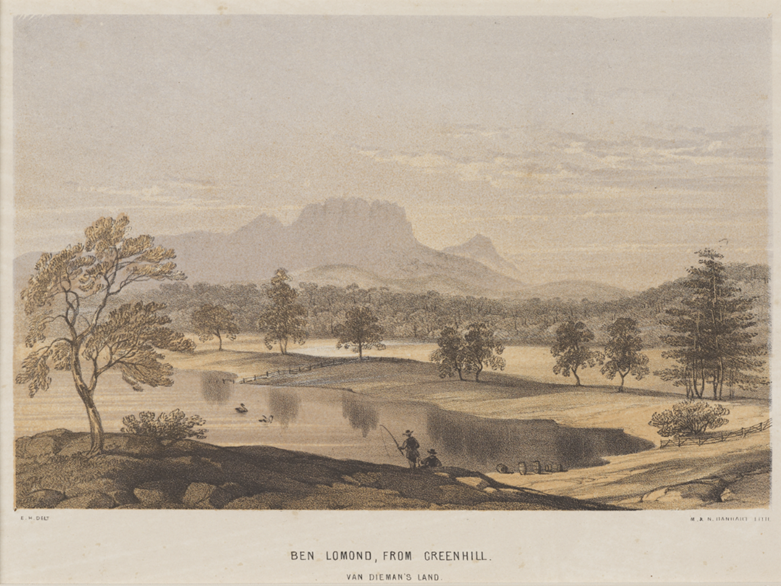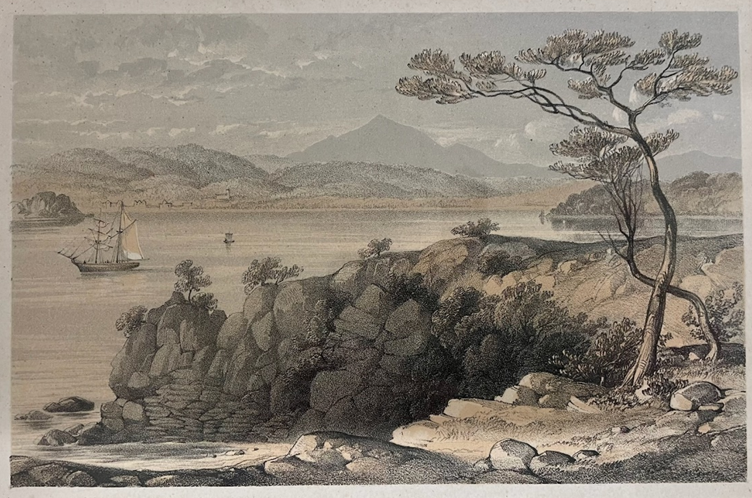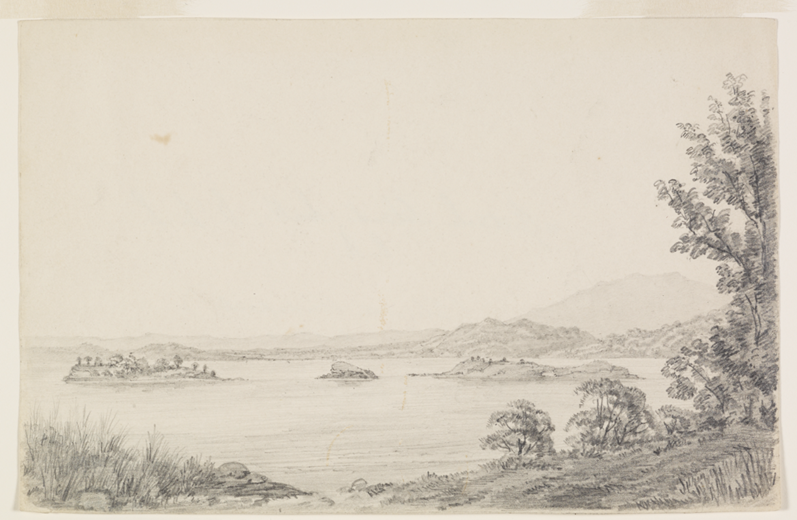Stories from the Royal Society of Tasmania Art Collection
12. Elizabeth Hudspeth (1820-1857)
Article prepared by the RST Honorary Curator, Dr Anita Hansen, for the April-May 2023 RST Newsletter.
The Amateur Tradition: Documenting Place

CHT Costantini (1803–1860),
1834. (private collection)
Charles Henry Theodore Costantini, Paris-born surgeon was transported to Australia twice. After some time in New South Wales, he was given a pardon and returned to England. Shortly after returning, he was found guilty of theft and transported to Van Diemen’s Land in 1827, where his skills as an artist as well as a surgeon were employed. On 14 March 1834, he received his freedom and was employed as a medical assistant to Dr John Maule Hudspeth, Elizabeth’s father, at Jericho. Around 1857 Costantini left Tasmania; by mid-1858 he was in Hawaii, where he died in October 1860.
It is possible that he taught Elizabeth some painting skills while he was employed by her father. But it must be remembered that her father was also an artist and would have encouraged her to draw and paint. The Royal Society of Tasmania has in its library, Elizabeth Hudspeth’s father’s journals from his whaling days in the Arctic. They are beautifully illustrated. They will form the basis for a future newsletter article.
Elizabeth Hudspeth (1820-1857)
Elizabeth Hudspeth is another of the often overlooked women amateur artists of the early European history of Tasmania.
As Joan Kerr, in her essay in honour of Geoffrey Thomas Stillwell (Allport Library and Museum of Fine Arts), when discussing a general lack of recognition of early colonial female artists wrote, ‘Women miniaturists and sentimental botanical and natural history painters were at the bottom of the artistic ladder in the nineteenth century and they remain there today.’
Later, when referring specifically to Sarah Ann Fogg and Elizabeth Hudspeth, ‘Such women neither modify nor confirm established myths; they simply have no place in our art histories.’
But, we owe so much of our knowledge and understanding of our early history to the very same women that are neglected today. Their recording of everyday lives and activities gives an insight into the minutiae of life in the early days of European settlement; the difficulties of living so far from family and friends; the difficulties of dealing with the unfamiliar landscape and surroundings; or making a home in a new land so different from their homeland.
Sailing to Van Diemen’s Land
Elizabeth Hudspeth led an amazing, and at times tragic, life. She was born on 19 September 1820 at Bowsden, Northumberland, the eldest child of Dr John Maule and Mary Hudspeth.
At an early age John Hudspeth was apprenticed to a doctor as was the custom. After completing his apprenticeship he moved to London, finally receiving his Certificate of Competency from Sir Ashley Cooper at the age of 20. Hudspeth moved to London and after completing his medical training he became a surgeon on the whaler Inverness and visited Greenland, Davis Strait and Hudson Bay, before taking up private practice at Bowsden. By now, the Napoleonic Wars were over and competition from the arrival of a number of naval doctors made it difficult to earn a living, The Hudspeths decided to emigrate to Van Diemen’s Land.
When the Hudspeths emigrated, Elizabeth was left with relatives in England while her parents sailed to VDL in 1822. She joined the family at their property Bowsden, at Jericho VDL years later in 1831.
On her voyage to Tasmania, Elizabeth fell and injured her leg, which was amputated by her surgeon father shortly after her arrival. What dreadful beginning for her – to be left behind when her parents emigrated; to sail on her own to Tasmania; to be reunited when she was eleven years old; and then to suffer the injury to her leg.
The Lithographs


Caroline Jordan, in Picturesque Pursuits notes:
In late 1854, she [Elizabeth] wrote that she had visited the lithographers Messrs M and N Hanhart in Charlotte Street* … In February 1855 she ‘discharged their account for executing four drawings … She then had the long and discouraging trek around London enquiring at different print sellers if they would undertake to dispose some lithos., carrying the specimens with them to show them, but in vain – they were quite “out of their line” – too small and not sufficiently interesting.
Jordan later writes:
Several of these prints found their way back to public collections in Australia, so perhaps Elizabeth ended up distributing them among her friends and family.
The two hand-coloured lithographs in the Royal Society of Tasmania Art Collection were bequeathed to the Society by her nephew Wilfred Hugh Hudspeth in 1952.
*The lithographic publishing house founded in London by Michael Hanhart (later joined by his brother Nicholas) had a long and successful history. It published its first prints in 1840 and continued to produce work beyond 1888. The firm published everything from book illustrations to lithographic sheet music covers.
Spectacle Island

The Royal Society of Tasmania also has in its art collection a pencil sketch attributed to Elizabeth Hudspeth. There is no record of how it came to be in the collection. It was originally attributed to Emma Haller. On the back of the sketch, in pencil, is written; possibly by the artist’s hand ‘Spectacle Island, Sorell, V.D.L./EH’; as well as ‘Elizabeth Hudspeth/c1840’.
Leaving Van Diemen’s Land
Elizabeth Hudspeth left Van Diemen’s Land in 1854 after the deaths of her parents and younger brother. She spent some time in New South Wales, but then left Australia forever.
Her mother had died of tuberculosis, and Elizabeth had contracted the disease while nursing her and her two sisters, who also died at that time.
She died at the age of just thirty-eight, having led a short, but remarkable life and leaving us the legacy of her art.
References
Information for this article was gathered from:
- The Royal Society of Tasmania archives;
- Picturesque Pursuits, Caroline Jordan;
- Elizabeth Hudspeth, Robert Stevens (Australiana, Feb 2017);
- Elizabeth Hudspeth, Patricia Clarke, Design and Art Australia Online (daao.org.au);
- Costantini, www.portrait.gov.au/people/charles-henry-costantini-1803, article by GT Stilwell, 1992.
The Royal Society of Tasmania’s Art Collection is housed at the Tasmanian Museum and Art Gallery, Hobart.
Any queries, please contact the Honorary Curator, Dr Anita Hansen: anita.hansen@utas.edu.au
